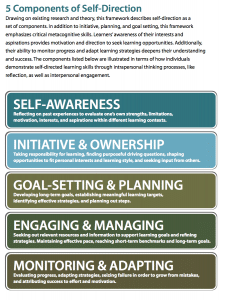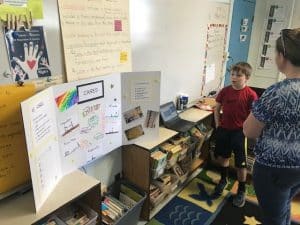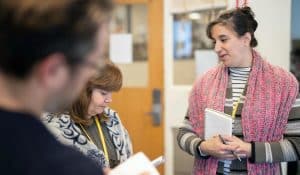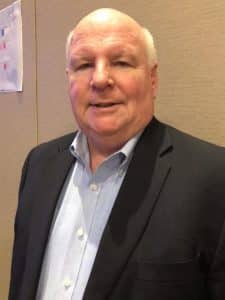Recognizing the Critical Importance of Metacognition
CompetencyWorks Blog
This is the second in a series of blog posts about New Hampshire’s work study practices—essential competencies such as communication, collaboration, and self-direction. Links to the others posts are below. This article explores the foundational role of metacognition in developing and deepening work study practices.
Metacognition: The Common Thread
When we first began learning about the work study practices (WSPs) and supporting teachers in developing them within the classroom, our initial lens was focused on assessment (in hindsight, really on reporting). We believe this was the wrong lens to initially be looking at these competencies through. As our understanding and experience with teachers and in classrooms has evolved, we’ve come to believe very strongly that metacognition is the critical lever in this work. A student’s understanding of where they are within their learning, as well as how to move forward armed with the skills, understanding, and feedback to monitor and adapt is crucial for success in any pathway, college, or career. This is also captured in the 7th element of the new definition of competency-based learning: “Rigorous, common expectations for learning (knowledge, skills, and dispositions) are explicit, transparent, measurable, and transferable)” (Levine and Patrick, 2019).
Students must know where they are and where they’re trying to get to be successful in learning, and this is precisely what metacognitive practices capture. The Essential Skills and Dispositions Frameworks (Lench et al, 2015) provide direction for utilizing the components of metacognition as the guardrails for developing these deeper competencies. For example, in the visual below, the top and bottom components (Self-Awareness and Monitoring & Adapting) “sandwich” the other three components of self-direction.

Teachers have been incredibly creative in how this is done, but ultimately, as they provide opportunities for students to reflect and develop an awareness of where they are in a skill (like being a self-directed learner), students can begin to think specifically about where they want to be, and importantly, how to get there. Opportunities for students to monitor and adapt are critical and very often have to be explicitly incorporated into the structures of learning. Scaffolding is critical, especially at the beginning. Over time, students take on more and more of this responsibility, truly becoming more agentic in all aspects. This, however, does take time.
Terry Bolduc, 3rd grade teacher in Timberlane School District, outlined her approach to developing and deepening metacognitive practices with her students and the impact this has on them as learners and as humans:
“When I introduce my students to work study practices, it involves a lot of talking and taking advantage of any opportunity to bring events and situations back to the importance of work study practices. Once I can show them examples of work study practices in action, only then can they begin the important work of actually thinking about them. I have had students tell me that they set work study practice goals, in the beginning, because I asked them to. Not always understanding the importance of them early on. But, as time passes, and they truly begin to think about them on their own, it’s that metacognition—the thinking about their thinking—where I am able to hook them.
“Children are able to verbalize that they find themselves thinking about how they can be more self-directed. Instead of sitting on the couch waiting for Mom to come down stairs and tell them to start getting ready for school, they take it upon themselves to start getting ready. Instead of coming in from recess and wandering around the room, they realize they know what’s coming next, and they can prepare themselves. They can actually be a self-starter. That’s the true power of teaching children about work study practices—when they actually put them into practice on their own and realize it makes things easier for them.”
In summary, once students understand “the why” themselves, they begin to apply these skills in their own lives.
Assessing For Learning: Developing Agency Through Co-designed Learning Experiences
There are those in the assessment world who don’t believe that these deeper learning competencies can be assessed reliably. Dr. David Conley however, proffered a big bet that he could create a framework that could capture this learning developmentally, if not in a progression. This resulted in the creation of the EPIC (and later, C!E) Essential Skills and Dispositions Frameworks, constructed by a team led by Sarah Lench, now of C!E.
In New Hampshire, we firmly believe that we can reliably assess these critical competencies in ways that are FOR learning rather than merely an end-point determination. This led to another big bet, this time by the New Hampshire Learning Initiative (NHLI) and the New Hampshire Department of Education (NHDOE), that New Hampshire educators and students can reliably demonstrate these success skills as embedded in the common performance assessments of New Hampshire’s Performance Assessment of Competency Education (PACE) system. Forming a research-practice partnership with Jobs for the Future (JFF), headquartered in Boston and funded by the Hewlett Foundation, NHLI is working closely with social studies and other secondary educators in New Hampshire to develop a system to prove out this second wager.
Our emphasis on the WSPs over the past four years as a grantee of the Assessment for Learning Project (supported through the Gates Foundation and the Hewlett Foundation) has allowed teachers across K-12 to dig into how these practices are included in instruction and assessed for learning. That is, that students are engaged in a co-designed process to build a body of evidence of growth and learning related to these competencies. An example of this is how students were able to design what their learning artifacts would be when they were developing resources for other students in their school related to CARES (the Responsive Classroom’s framework of Cooperation, Assertion, Responsibility, Empathy, and Self-Direction). These were kindergarten and first graders, but with scaffolding they were successfully able to determine for themselves how to share their learning in a meaningful way.

Our initial attempts at collecting evidence proved difficult. We were faced with questions about what actually constituted evidence. Some of the best examples of evidence ended up being the voices of students discussing how the WSPs impacted their work and ability to be successful in the classroom. This effort began to change our thinking about the role of students in assessment. Thereafter, our Assessment for Learning Project work relied heavily on students being co-creators of learning experiences through all aspects of curriculum (determining competencies), instruction (what learning would entail, through project-based experiences), and assessment (determining what evidence could be used to demonstrate growth). As a result, the WSPs became an integral focus, with metacognition being the common thread throughout. This article, written by teacher Sarah Benson and Jonathan Vander Els, delves into what this co-design looks like in a primary classroom.

The reflections of teachers, as they gave more ownership in learning to their students, were telling. Jennifer Manning, a kindergarten teacher from Memorial School, reflected on the discomfort that she felt ceding control: “Students’ choice can lead to increased engagement and more ownership for individual learning. We had a loose plan for students and their work in the project. I have seen students be engaged by taking the lead on where their learning will progress. I had to overcome how uncomfortable this felt, but letting students take the lead has been powerful for all of our learning.”
Teachers’ and students’ increased comfort with “co-designed” learning experiences has naturally led to greater opportunities for a focus on the WSPs and specifically metacognition. Students are practicing self-direction, collaboration, communication, and innovative, creative thinking to solve real-world problems, designing learning together with their teachers. The “assessment” of these skills is truly FOR and AS learning, not solely OF learning. And students who are successfully engaging in metacognition, understanding where they are as learners, and who develop a plan to get to where they want to be, with an ability to monitor and adapt their own growth, will be more successful in their pursuits after high school.
Recognizing Emerging Threads Through Classroom Practice and Research
There was a recognition that for this work to truly flourish, we needed to begin to look at how to deepen and scale our efforts, at the classroom level, with teachers but also through a research lens to determine what was most effective. A research-practice partnership between NHLI, JFF, CIE, the NH Department of Education, and KnowledgeWorks, supported by the Hewlett Foundation, emerged as the next step. This collaboration began with a shared belief and interest in seeing WSP instruction and assessment grow, deepen, and diffuse over time.
The question we were grappling with was how to do this effectively. The work evolved over the course of its existence, something that has become a hallmark of this project. Initially, we were looking closely at the connection between a student’s level of skills in the WSPs and the academic content areas and how to scale this learning within and across districts and schools. We also were specifically looking at possible gaps with students furthest from accessing learning.
This evolved into a question about whether these deeper learning competencies could be assessed. Currently, our focus question asks whether we can assess WSPs validly and reliably, given the subjectiveness of this type of assessment. As Dr. Felicia Sullivan, lead researcher on this project from JFF, noted as it relates to this last point, “formative calibration suggests teachers can agree on what self-direction looks like and have strong interrater reliability or consistency of scoring across classrooms and districts” (please see Dr. Sullivan’s recent article on teachers as agents of change). We are hoping to see this realized through the collaborative processes for teachers embedded in this project.
A few key takeaways, captured through videos on this link, have come to the forefront. With our focus on self-direction, teachers have experienced significant growth in their understanding of what this particular work study practice actually entails. Some teachers initially thought of self-direction as more behavioral in nature. For example, some connected self-direction to turning in homework on time (i.e., did students do it or not?). But now teachers are seeing self-direction as a comprehensive competency that can help a learner be successful in any realm of their life. With opportunities to practice agency and take charge of their learning, students will develop skills that will have a lasting impact on their life. Through our current work in self-direction, STUDENTS are analyzing for themselves (to continue with this homework example) whether they did their homework and recognizing that it may have had an impact on how successful they were. Students are then able to set meaningful goals and work toward realizing them, with support from their teachers.
Teachers have truly taken a lead in moving our work forward, with a groundswell of effort and top-down support. They are incredibly interested and invested in understanding how the WSPs support students in being more successful. Teachers have also really dug into the essential skills and dispositions—recognizing the role metacognition plays in learning and applying these structures consistently within classroom learning experiences with reflection as a key component. As Dr. Karin Hess, one of our expert advisors noted, “We get to metacognition through reflection. Metacognition occurs during the learning process when learners become aware of and monitor their learning in the moment. We look for evidence of metacognition through self-reflection activities, when learners analyze the effectiveness of decisions made while learning—determining what worked well for me and what will I do differently next time, and why.”

This learning process for teachers goes right to the heart of our work. Teachers have to come to the realization that they have to provide “space” for reflection in their classrooms, and providing space means giving time. In a system that is increasingly crunched for time, this becomes critically important. But as Terry Bolduc says about time spent embedding reflection and metacognition on the WSPs in her classroom, “All the time you put in at the beginning of the process comes back to you later because students are more independent and more easily redirected.” This is crucial to note, because oftentimes in a change process, educators will point to a lack of time as a barrier to taking on anything more. For those who experience what Terry has described, not taking the time is not an option.
In a fully agentic model, each and every student, regardless of grade level or academic achievement level, will be taking the lead on their learning. Again, this leads us back to metacognition. In a fully transparent model, teachers will be giving up control to students in this process, because ultimately every student will be in a different place in their reflection, goals, and ability to monitor and adapt.
This begs the question of how to manage the process in the classroom. Kathy White, Dean of Instruction from Souhegan High School, and the project director for Scaling WSP in New Hampshire, noted that “formative assessment (which relies on self-direction and collaboration skills) is a lever for increasing student agency, which is ultimately what we’re trying to achieve.” Students must know where they are and what the learning goals are to understand where they need to go and how to possibly get there.
This recognition of formative assessment as integrally intertwined within the WSPs has been critical. One of the troubling aspects of beginning to embed WSPs across districts was the realization that if students saw their honest reflections as potentially coming back to haunt them in the form of a “grade,” all might be lost. In this vein, there was a deliberate attempt to go back to the original idea of Fritz Mosher and David Conley, in applying a learning progression approach to the work study practices (what they were referring to as the Essential Skills and Dispositions).
Based upon our learning and recognizing that essential skills and dispositions have not been researched as a learning progression, Dr. Karin Hess and Wendy Surr, senior research consultants, are currently applying the concept of a learning progression to refine the original rubrics used in New Hampshire to assess the work study practices. Learning progressions reflect growth, whereas rubrics suggest an assessment of where students should be. Hess and Surr’s work will allow us to address the tension of wanting to assess in meaningful ways, while also capturing, through evidence, where students are. In so doing, we hope to avoid the traditional punitive ways that “grading” has wrought.
The final post in this series explores the work study practices as a lever for equity in schools, their foundational nature in instruction and assessment, and how “grading” them can be counterproductive.
Learn More
- New Hampshire’s Work Study Practices – A Five-Year Journey to Understand, Share, Scale, Deepen, and Meaningfully Assess These Critical Competencies
- New Hampshire’s Work Study Practices – Equity and Assessing For Growth
- Promoting Lifelong Learning Skills in the Classroom: New Hampshire’s Work Study Practices

Jonathan G. Vander Els directs innovative, competency-based projects for the New Hampshire Learning Initiative and is co-author of Breaking With Tradition: The Shift to Competency Based Learning in PLCs at Work (Solution Tree, 2018). Formerly, Jonathan was a principal in an elementary school recognized nationally as a model professional learning community and competency-based school. Jonathan has consulted, coached, and presented at conferences and institutes throughout the United States, and lives with his wife and three children on the NH Seacoast.
 Ellen Hume-Howard is Executive Director of the New Hampshire Learning Initiative. In this role, she supports NHLI’s vision to assist New Hampshire schools and districts to deepen their innovative practices in education and improve learning for all students. Ellen has also worked with state and national experts to design a competency assessment program using performance assessment for state accountability. Ellen currently serves as the curriculum director for the NH PACE project.
Ellen Hume-Howard is Executive Director of the New Hampshire Learning Initiative. In this role, she supports NHLI’s vision to assist New Hampshire schools and districts to deepen their innovative practices in education and improve learning for all students. Ellen has also worked with state and national experts to design a competency assessment program using performance assessment for state accountability. Ellen currently serves as the curriculum director for the NH PACE project.
 Paul Leather is Director of the Interstate Learning Community for the Center for Innovation in Education. Mr. Leather’s background and experience in Education, Counseling, and Administration in New Hampshire spans four decades. He served as the Deputy Commissioner of the Department of Education in New Hampshire for eight years, and has also served for 18 years as the Director of the Division of Career Technology and Adult Learning for the Department, overseeing numerous statewide initiatives and programs. In 1997, Mr. Leather began a journey to create a state model for competency-based education. This effort resulted in the development and implementation of the NH student mastery model now in place as part of New Hampshire’s system. More recently, he led the development of a first-in-the-nation next generation educational accountability model, called “Performance Assessment of Competency Education,” or PACE, approved as a pilot program by the US Department of Education, starting with four New Hampshire districts in March 2015. For the Center for Innovation in Education, he co-leads the 8-state Interstate Learning Community and the Intermediary Organization Learning Community with Gretchen Morgan.
Paul Leather is Director of the Interstate Learning Community for the Center for Innovation in Education. Mr. Leather’s background and experience in Education, Counseling, and Administration in New Hampshire spans four decades. He served as the Deputy Commissioner of the Department of Education in New Hampshire for eight years, and has also served for 18 years as the Director of the Division of Career Technology and Adult Learning for the Department, overseeing numerous statewide initiatives and programs. In 1997, Mr. Leather began a journey to create a state model for competency-based education. This effort resulted in the development and implementation of the NH student mastery model now in place as part of New Hampshire’s system. More recently, he led the development of a first-in-the-nation next generation educational accountability model, called “Performance Assessment of Competency Education,” or PACE, approved as a pilot program by the US Department of Education, starting with four New Hampshire districts in March 2015. For the Center for Innovation in Education, he co-leads the 8-state Interstate Learning Community and the Intermediary Organization Learning Community with Gretchen Morgan.